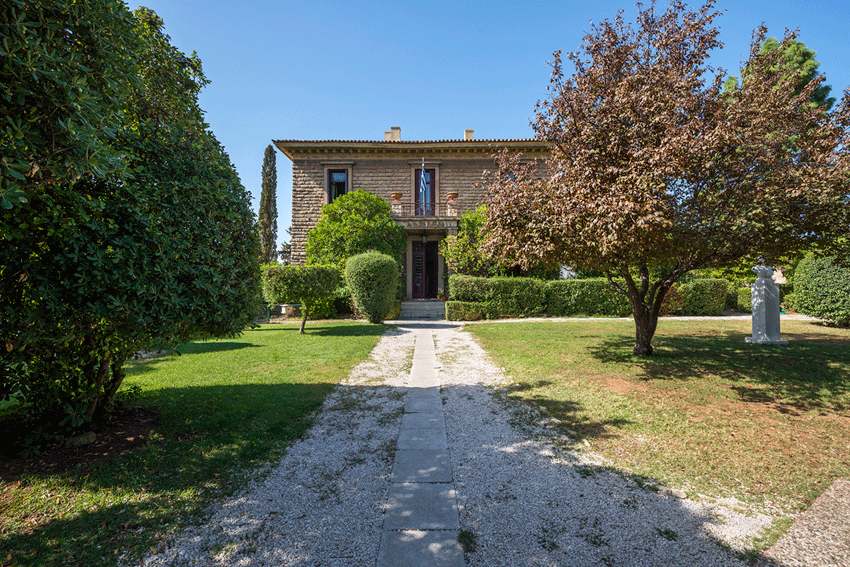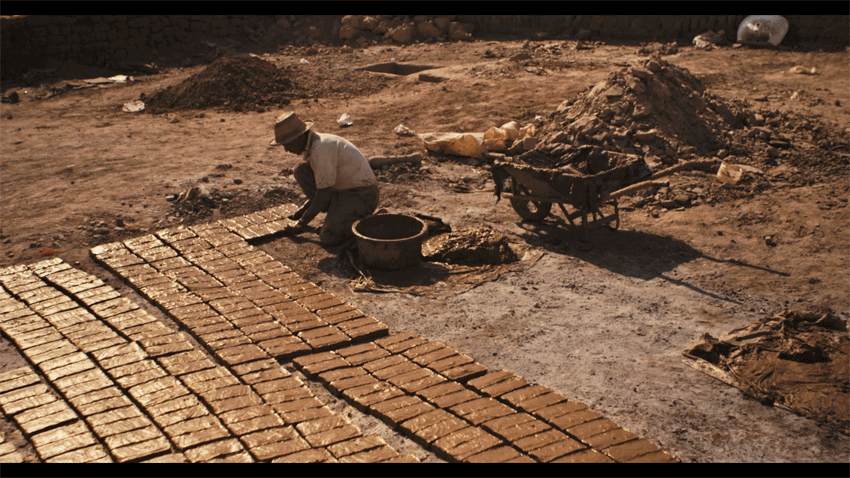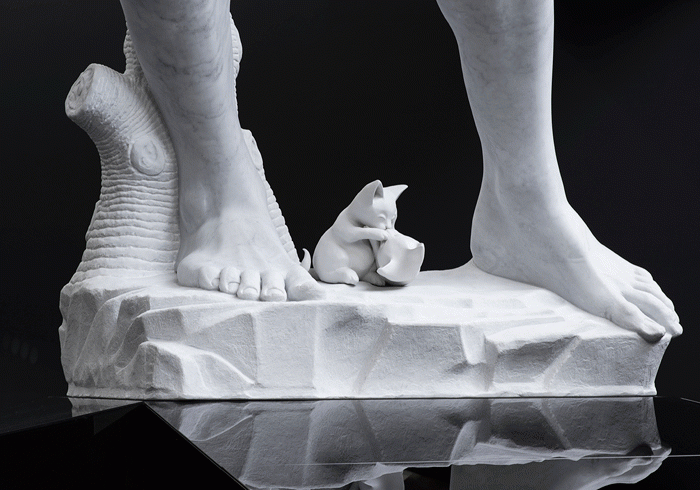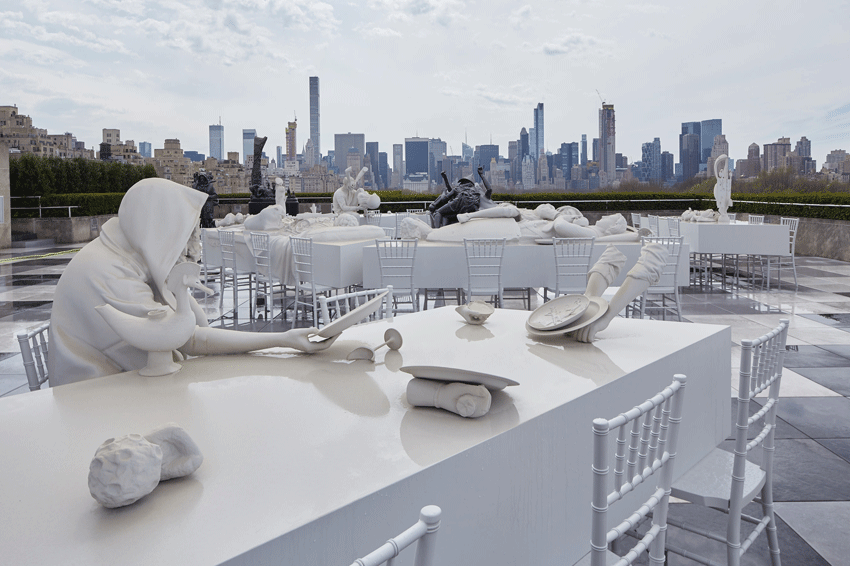In March 2015 I walked through the lanes of Büyükada, an island that lies an hour’s slow ferry ride from Istanbul, eventually coming to the track that leads down to the ruins of the villa in which Leon Trotsky lived between 1929 and 33. The garden, its grass long and pocketed with wild alliums, ends at the shoreline. I walked to the edge and stared out to the Sea of Marmara. I remember thinking this place had a strange, almost magical quality. It seemed out of time, despite evidence of time’s march surrounding me in the building’s decay and overgrown grounds. Here the natural world operated on its own terms, unhindered by human presence.
Later that year, in September, the 14th Istanbul Biennial opened. Trotsky’s old home-in-exile was the venue for The Most Beautiful of All Mothers, a largescale installation by Adrián Villar Rojas. A few feet out in the water an elephant stood on a platform. It was flanked by a gorilla and a giraffe, each marooned on its own island. More creatures – a menagerie – were scattered farther out. The animals, imposing and classically sculpted, dazzled white in the late summer sun (the work’s caption merely noted that these sea-weathered sculptures were made from ‘organic and inorganic materials’), the effect only broken by the mass of debris the artist had heaped over the backs of these beasts: a bison shouldering driftwood, disintegrating fabric and slowly rotting fruit; a kangaroo managing a bundle of sticks, ivory and fur; a big cat cowering under a rusting anchor. Others were burdened with creatures – or parts thereof, fashioned in unfired clay – the head of a moose for example could be seen a little way out, fused to the back of a rhino. This scene, in which seemingly once-proud statues were overcome by flotsam and jetsam that looked to have accumulated over an extended period, or had freakishly mutated, led me to the fanciful notion that these works weren’t a newly arrived addition to the landscape (despite my knowledge to the contrary) or temporarily installed (despite all logic), but had been here for an age.
The Theater of Disappearance, 2017 (installation view, Metropolitan Museum of Art, New York). Photo: Jörg Baumann. © the artist. Courtesy the artist and Marian Goodman Gallery, London
Artifice, the environment, the confusion of time – and indeed spectacle – are the abiding themes of the Argentinian artist’s work
Artifice, the environment, the confusion of time – and indeed spectacle – are the abiding themes of the Argentinian artist’s work. Villar Rojas is best-known for his substantial installations, and his exhibitions tend to be ambitious, both formally and philosophically. The artist’s current projects, for the rooftop of New York’s Metropolitan Museum of Art and the National Observatory of Athens, both titled The Theater of Disappearance (as was the artist’s recent Kunsthaus Bregenz show and as will be his upcoming exhibition at the Geffen Contemporary at MOCA, Los Angeles), are cases in point. New York has seen myriad apocalyptic fates befall it at the hands of Hollywood, but Villar Rojas’s installation at the Met is one of the more sublime visions of Armageddon. We don’t see the fall of civilisation, just the apparent aftermath: replicas, or partial replicas, of almost a hundred objects from the museum’s collection rendered in both white and black plaster are installed alongside sculptures of human figures – their haircuts and clothes modern – and everyday objects, likewise in plaster. Arranged haphazardly across the Met’s roof are several dinner tables, rendered in ghostly white, the remnants of a meal still evident, wine glasses overturned as if catastrophe has interrupted celebration. Artefacts that, downstairs, within the museum, have been carefully sorted chronologically, taxonomically and geographically, here intermingle with the aborted feast. The sad, petrified bodies of Pompeii are an obvious reference point. A knight reclines close to a vase. A replica of an otter sculpture stands near the edge of the roof. A thin layer of dust covers the entire installation. The uniform palette of these copies all but erases the details that otherwise might tie them to a particular time or place (in fact the knight is derived from a thirteenth-century French statue in the museum’s collection, the vase is late seventeenth-century Mexican, the otter is an icon of the Ptolemaic Period). Villar Rojas’s play with temporal confusion serves a greater end: time, in essence, is a human tool to measure and keep record of our finite presence on the planet, so such confusion of chronology – or its absence – here and elsewhere in the artist’s work suggests the absence of humanity. The recurring presence of animals in the work directs our attention towards the natural world. Put these interests together and one has a practice that is loaded towards tackling the Anthropocene, the suggestion that humanity’s effect on the earth’s ecosystems is so great that it can be deemed a new geological age and will ultimately lead to our destruction (and that of many other species).
Villar Rojas has made repeated use of Michelangelo’s David (1501– 4), or rather the legs of the young shepherd, as a motif, placing them in installations that mimic an imagined postapocalyptic landscape. These muscular limbs first appeared in Lo que el fuego me trajo (What Fire Has Brought Me), a 2008 exhibition at Ruth Benzacar gallery, Buenos Aires. There they stood among rubble the artist had spread across the floor of the gallery’s basement space, surrounded by ruined walls and other crumbling statues. Shelves lined the gallery walls, hosting a vast array of disparate objects and characters, which, modelled in unfired clay, came together like fossils of the future. The limbs returned in Villar Rojas’s exhibition at the Serpentine Sackler Gallery in London five years later, again as just one of many unfired clay sculptures (depicting animals, agricultural implements, bones and abstract geometric shapes) on shelves that lined the space; but this time a kitten played at David’s feet – a clay copy, the artist has stated, of a kitsch objet d’art he had bought in a Buenos Aires pottery shop, another example of the artist envisaging a future in which manmade cultural hierarchies lose their relevance. Both display cracks in their surfaces (as the clay expanded while drying) and are in a state of disrepair. The image of David – the ‘perfect’ human of classical imagination – is imagined decaying in a world that humans have vacated.
While so much of his work has sought to present a world in ruins, devoid of humanity, his primary subject is ultimately a portrait of human presence, a rumination on the dangerous results of human activity on the planet
Villar Rojas has said he wants to be ‘parasitic’ in his approach to these largescale projects, working in a symbiotic relationship with the host institution, in which the work takes from the venue as much as it gives. This approach is apparent in his decision to plant approximately 46,000 plants from 26 plant species on the land around the observatory in Athens – including wild grasses, grains, fruit and vegetables – which will turn this normally politely landscaped space into a wilderness, the foliage perhaps becoming, during the four months of the show, as long and overgrown as the alliums and grasses of Trotsky’s garden. (In actual fact, due to strict preservation rules, the planting is done into soil that sits on top of a membrane that protects the existing ground; this sort of spectacular artifice is a recurring theme in the work.)


The Theater of Disappearance, 2017 (installation views, National Observatory of Athens). Photos: Panos Kokkinias. Courtesy Neon, Athens
While so much of Villar Rojas’s art over the past decade has sought to present a world in ruins, devoid of humanity, his primary subject is ultimately a portrait of human presence, a bitter (if also poetic) rumination on the dangerous results of human activity on the planet. This explains the melancholic feeling that hangs over so many of his installations. That said, I think there’s also an often overlooked strain of admiration for our species in the artist’s practice, a wonderment for an animal that can produce all the treasures of the Met, or build an observatory housing telescopes capable of seeing stars far into space. The artist has described man as having ‘extra powers’ that nonhuman animals do not.
Nowhere is this rueful admiration clearer than in the artist’s occasional forays into videomaking. Both Lo que el fuego me trajo (2013) and Unknown Soldier (2016) are slow, beautifully shot studies of humankind at work. Ahead of the 6th Marrakech Biennale, at which Unknown Soldier premiered, Villar Rojas travelled to the nearby Moroccan villages of Tameslouht, Ourika, Oumnass and Asni, capturing on camera vernacular craftsmen, particularly potters and brickmakers, going about their business. In Lo que el fuego me trajo (Villar Rojas often settles on a title that he’ll then apply to a wide variety of works) the artist turns the camera on his own craft. The video is set in Lina Bo Bardi’s Casa de Vidro, which the Italian architect built for herself on the outskirts of São Paulo, and this is also where the work was first shown (in a group show, The Insides Are on the Outside, curated by Hans Ulrich Obrist in 2013). It captures Villar Rojas’s ‘studio’ team (a large group of multiskilled people, many of whom he has worked with for years, and who travel with him en masse wherever he shows) working on various projects inside and outside the house: moulding small clay figures, stripping back bamboo on the grounds, erecting a structure of unknown purpose. The 21-minute video is dialogue-free. As in Unknown Solider, shots linger over workers’ fingers as they go about their work, inviting the viewer to marvel at the dexterity of the human animal, at the ingenuity evident in the experimentation and problem-solving. As we see these people making a living, moving through the space inside and out, leaving traces of their finite time on this planet, all that can be heard is the sound of crickets and rain hitting the lush, dense forest that threatens to envelop this place.

The Theater of Disappearance is on view at the Metropolitan Museum of Art, New York, through 29 October, and was on view at the National Observatory of Athens/NEON through 24 September. It will be at the Geffen Contemporary at MOCA, Los Angeles, from 22 October to 26 February.
Oliver Basciano is editor (international) of ArtReview. This article originally appeared in the September 2017 issue of ArtReview

